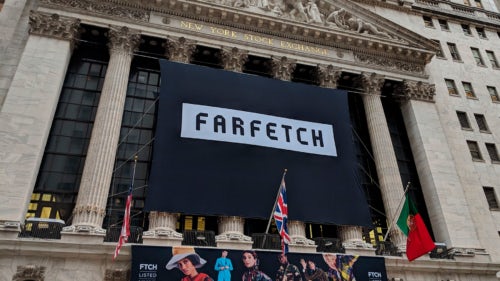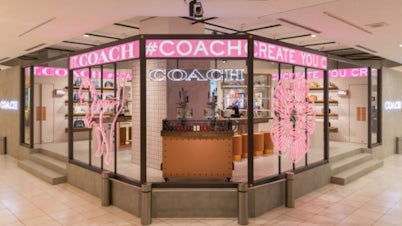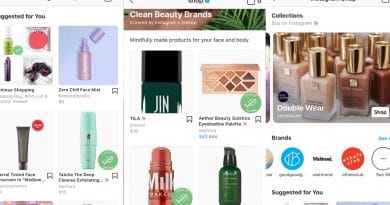Is Luxury E-Commerce Still Booming? | BoF Professional, The Week Ahead
THE CHEAT SHEET
Farfetch‘s Pandemic Bounce

Farfetch reports second-quarter results this week | Source: Shutterstock
- Farfetch reports second-quarter financial results on August 13
- Unlike many of the brands it carries, the online luxury marketplace has seen strong sales as consumers turn to e-commerce during pandemic lockdowns
- Farfetch has yet to turn a profit; management says it’s on track to be in the black next year
Farfetch is on a roll. The company’s share price has more than tripled from its lockdown lows in April, and is likely to report another staggering increase in sales for the second quarter. The pandemic has created “perfect trading conditions” for the marketplace, writes Bernstein’s Luca Solca, who in the past has been skeptical of the company’s business model. Key competitors, including luxury brands and retailers, have been laid low by distribution problems — less of an issue for Farfetch, which mostly leaves storage and shipping to third-party sellers. And with everyone shopping online, customer acquisition is easier, potentially reducing one of the company’s biggest impediments to profitability.
Still, it’s an open question whether new customers will come back, and the e-commerce boom is likely to attract new entrants into an already overcrowded market. Like other multi-brand retailers, Farfetch is also going to have to work to keep the most desirable labels on its site; in recent weeks, LVMH, Burberry and other luxury brands have said they are taking steps to steer more sales through their own channels.
The Bottom Line: Farfetch has shown it can grow sales — now it needs to demonstrate it can turn a profit too.
What’s Next for Tapestry?

A Coach pop-up store | Source: Courtesy
- Tapestry CEO Jide Zeitlin resigned last month amid allegations he had entered into an inappropriate relationship with a woman years before
- The company is on its third CEO in less than a year, and has replaced all of its brand heads as well
- Sales and profits are expected to be down sharply due to the pandemic, though the company said results should be better than initially feared
Tapestry earnings were already going to be plenty dramatic even before the surprise resignation of the Coach, Kate Spade and Stuart Weitzman owner’s CEO. The company had previously said sales and profits would be better than initially expected in its latest quarter, and it has $1.4 billion in cash on hand to help it navigate pandemic disruptions and execute its turnaround. Look this week to hear more about what that plan actually is. Zeitlin had in March committed to a three-year tenure to design and execute a turnaround, and had replaced the heads of all three of Tapestry’s brands.
It’s not all bad news. A case could be made that the worst is over as stores reopen worldwide (though some have again closed in the US as new Covid-19 cases surge). Coach is less dependent on struggling department stores than many of its rivals. And unlike apparel-focused brands stuck with instantly dated spring collections, Coach and Kate Spade handbags aren’t seasonal and can be sold later, assuming handbags ever regain their pre-pandemic appeal.
The Bottom Line: Tapestry’s needs, from reducing discounting to reviving sales at Kate Spade, are as urgent as they were two CEOs ago.
Live Before a Studio Audience, It’s Copenhagen Fashion Week

Models at Ganni’s S/S 20 show in Copenhagen last August | Source: Yuliya Christensen/Getty Images
- Copenhagen Fashion Week, which runs August 9-12, will include a mix of digital content and shows in front of live audiences
- A few brands, including Valentino, Jacquemus, Etro and, last week in Shanghai, Louis Vuitton, have staged physical shows with live audiences since the peak of the pandemic
- More designers are expected to stage live shows at European fashion weeks in September
After the mostly digital free-for-all in Paris and Milan last month, Copenhagen’s schedule this week marks the first attempt to stage something akin to a conventional fashion week. The organisers are taking a “no rules approach” in terms of format. A handful of the roughly 30 brands showing are planning fully live shows with audiences. However, many others are expected to include some sort of physical component along with digital videos and live streams.
Denmark has largely reopened, making the logistics of holding fashion events easier than in locations where the pandemic is a bigger threat (though audiences for shows will be limited to a few dozen mostly local guests). The lack of international attendees is a major hurdle, only likely to be faced by designers in New York, London and beyond next month. Weak engagement with last month’s digital shows is a sign that designers still need a critical mass of celebrities, buyers and editors in the room to generate buzz and make a convincing case for fashion week. The fight for attention is nothing new for Copenhagen, a regional fashion week that sometimes operates in the shadow of Paris, London and Milan. Organisers say they’re planning for each designer to hold a Q&A, and a series of talks on sustainability, racism and other topics will take place alongside the shows.
The Bottom Line: In addition to showcasing Scandinavian designers, Copenhagen should provide a good test run for September, when major fashion capitals plan to host physical shows, presentations and events for the first time since the lockdowns.
SUNDAY READING
Professional Exclusives You May Have Missed:
The Week Ahead wants to hear from you! Send tips, suggestions, complaints and compliments to [email protected].
Was this BoF Professional email forwarded to you? Join BoF Professional to get access to the exclusive insight and analysis that keeps you ahead of the competition. Subscribe to BoF Professional here.


